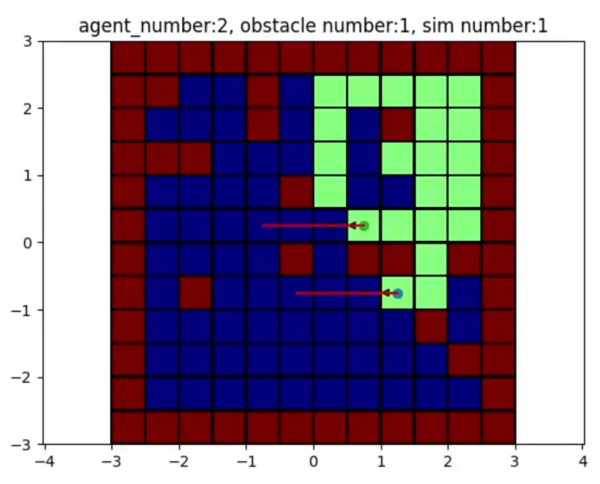WP4-10: Difference between revisions
(Add some more text) |
|||
| Line 35: | Line 35: | ||
The concept behind the Cooperative planner has been tested through the graduation work of Vibhav Kedege. He looked into the challenge of having multiple agents work on a shared goal (in this case an exploration mission). He compared the theoretical optimal global, shared information model with a model in which the agents can only communicate with physical nearby agents (=other drones) and looked at how well the reduced effectiveness can be recovered. This showcases how an inherently distributed task/mission can be achieved by cooperative drones, even without the need for global knowledge. | The concept behind the Cooperative planner has been tested through the graduation work of Vibhav Kedege. He looked into the challenge of having multiple agents work on a shared goal (in this case an exploration mission). He compared the theoretical optimal global, shared information model with a model in which the agents can only communicate with physical nearby agents (=other drones) and looked at how well the reduced effectiveness can be recovered. This showcases how an inherently distributed task/mission can be achieved by cooperative drones, even without the need for global knowledge. | ||
[[File: CooperativePlannerExample.png|thumb|upright 2|center|Example of cooperation between drones]] | |||
Revision as of 10:52, 15 March 2023
Cooperative Planner
| ID | WP4-10 |
| Contributor | ALMENDE |
| Levels | Platform, Function |
| Require | |
| Provide | Navigation goals, at Global-Planner level, shared among drones |
| Input | ROS TF/map data, shared among multiple robots |
| Output | ROS navigation goals, also shared among mutliple robots |
| C4D building block | |
| TRL | 4 |
| Parent Building block | [] |
| Contact | ludo at almende.org |
Description
This component provides support for cooperation between drones and rovers, on a (global) planning level. By sharing a drone's plans, in a standardized manner, more optimal group behavior can be achieved, through a group planner component. By designing this group planner through multi-agent techniques, this planner can be distributed over multiple robots.
Improvements
In the research fields of game-theory, multi-agent systems, and service orchestration, several strategies for cooperation have been developed. Most of these strategies have not yet been applied within a robotic environment, nor has there been much focus on cooperating robots. An exception to this is the field of Robotic Soccer and similar competitions and challenges, which apply voting-based planning through shared playbooks and role-assignment. This component allows trying out such algorithms and strategies for any ROS-based system, by extending the navigation stack with a cooperative planner, on top of the current standard local and global planner.
Validation
The concept behind the Cooperative planner has been tested through the graduation work of Vibhav Kedege. He looked into the challenge of having multiple agents work on a shared goal (in this case an exploration mission). He compared the theoretical optimal global, shared information model with a model in which the agents can only communicate with physical nearby agents (=other drones) and looked at how well the reduced effectiveness can be recovered. This showcases how an inherently distributed task/mission can be achieved by cooperative drones, even without the need for global knowledge.
